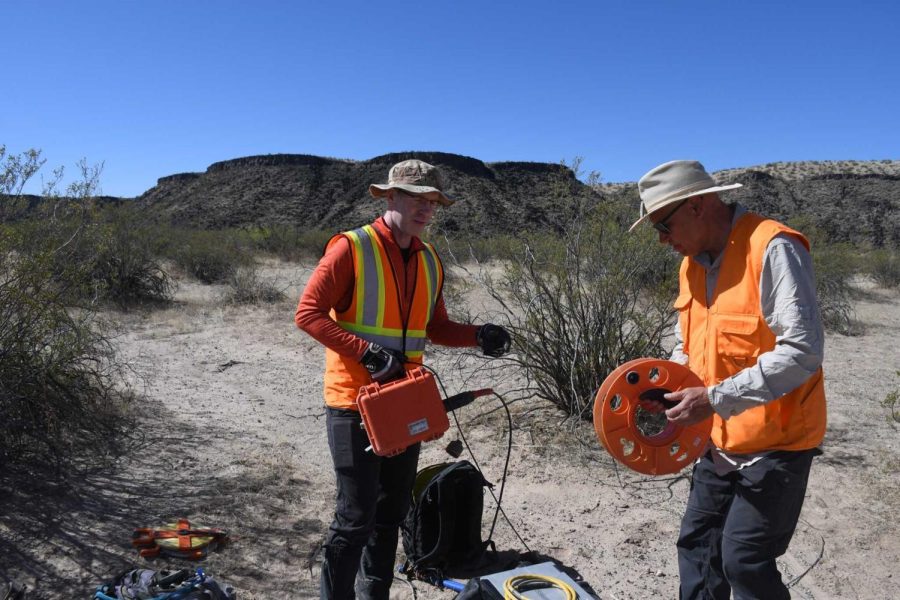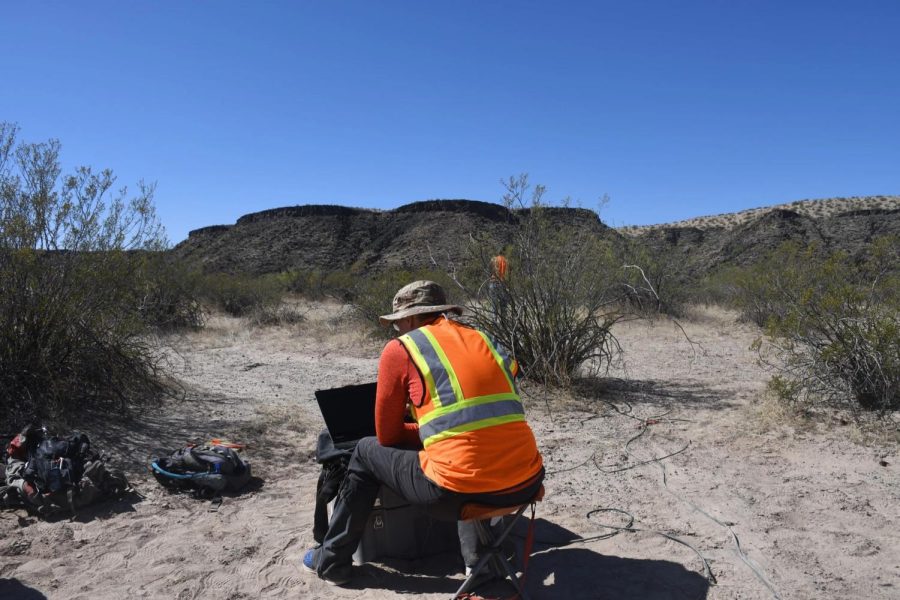Planetary Geophysicist Ernie Bell collected seismic data using geophones at Potrillo Volcanic Field in New Mexico in April 2022
How Study of Volcanoes Unearths Mysteries of Planets
March 20, 2023
The earth has untold tales throughout its history – and so do other planets. Scientists, like Ernie Bell of NASA’s Goddard Space Flight Center in Maryland, hope to uncover the stories embedded in the earth to help people gain a better understanding of other planets.
That’s the premise that brought teams of scientists to check out seismic activity at Potrillo Volcanic Field in southern New Mexico. The volcanic field is a rich area of research for scientists who see it as an “analog,” a kind of geological parallel, to bodies in space such as the moon and planets. They hope to not only better understand seismic activity but also any complications arising from living near a volcanic area.
“We gather the basic data to allow us to learn more about how the geological features of Kilbourne hole (Potrillo) were formed and will also help us figure out how to test and investigate features like this on other planets,” said John West, a retired seismologist and engineer volunteering in the field to help collect data.
Science runs on data. The lead seismologist will take back this data to their office and analyze. Hopefully, we can look at what’s underneath the crater and give them ideas on what works and what might not work to have astronauts do this on other planets.
— John West
Scientists are trying to understand what our planet has to offer and what other planets endure. For that, NASA scientists at Potrillo like West and Bell set up an array of geophones along the rims of Hunts Hole and Kilbourne Hole – 24 in all – spaced 16 feet apart.
The geophones — which are cylindrical white boxes that stand about 7 inches tall and are about 4 inches in diameter — record vibrations within the ground. You could think of it as a bat sending out frequencies and receiving them back, knowing what lies ahead.
Researchers place a small square metal slab near the geophone and hit the slab with a sledgehammer. The geophone starts picking up signals as soon as the hammer makes contact with the metal slab.
Scientists attached an electronic trigger to the sledgehammer that detects when the hammer has made contact with the slab. The geophone and the electronic trigger are wired to a data collector, which translates the raw information from both instruments to a computer, which outputs images of the sensors collected.
For each geophone planted, scientists repeat making contact with the slab at least 10 times to make sure they have gathered enough data on each geophone. Copious amounts of ash present in the area made it difficult for seismic instruments to work on the first try.
“We mainly looked at the southern rim of the volcano today,” Bell said. “A part of that was to look at post-eruption deposition of eruptive material or post to eruptive materials which could be comparable to lunar craters and or lunar foldings.”

The craters of Potrillo are filled with volcanic ash. It looks pretty similar to sand, but it’s much more refined, more like a powder. The ash sometimes can distort the waves that the geophone sends down into the earth. Ash and sand are very fine and loose materials that create “noise,” making it difficult to collect good data.
Noise consists of unwanted frequencies that arise from different factors: Researchers repeat the tests and then overlay the data collected to have a better “image” of the data collected.
The environment surrounding the Potrillo Volcanic Field is harsh. The area has several animals to watch out for, including some venomous ones, such as rattlesnakes.
People live near volcanoes, too, which is why seismic research NASA is conducting is essential even though it’s primarily geared toward other planetary bodies.
“Volcanoes are intrinsically a part of humans and a part of who we are as humans,” said Jacob Richardson, a planetary scientist at NASA’s Goddard Space Flight Center in Maryland. “Communities worldwide live near or around active volcanic fields, just as the one here at Potrillo. So many people, cities are built near or around volcanic fields.”
He added: “Like Auckland, New Zealand, Managua, Nicaragua, Flagstaff, Arizona – If another volcano eruption occurs, people can have a bad time. It’s important for volcano observatories in these places, and scientists, in general, to understand the processes that can make these eruptions happen.
As a planetary researcher, I get to look at other planets and bring some of that knowledge back to earth because we can see way more volcanoes in space than we can on earth. just because the earth erodes volcanoes quickly in a geologic time scale.
— Jacob Richardson, planetary scientist
